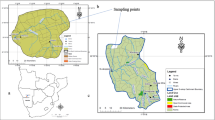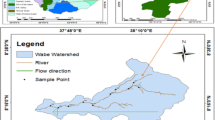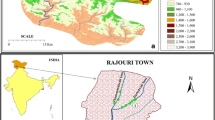Abstract
Rosetta and Damietta are the main branches of the Nile River in Egypt. They provide the required freshwater for different usage for about 20 million people. In the present study, chemical and biological indices were used to assess the water quality and provide a full image of the environmental status in the investigated area. Generally, the chemical parameters, except the dissolved oxygen, were at higher levels in Rosetta Branch when compared to Damietta Branch. Also, Damietta Branch frequently showed the presence of the macroinvertebrate families that are bioindicators of moderate and good water quality. Contrarily, the most resistant species to pollution were frequently recorded in the Rosetta Branch. According to Canadian WQI, the water of Rosetta Branch is classified from “marginal” to “poor” for the drinking and aquatic life uses and “fair” to “good” for irrigation usage. On the other side, the water quality of Damietta Branch is classified as “fair” with respect to drinking water and “good” to aquatic life and irrigation. Based on using macroinvertebrate families as bioindicators, the Biological Monitoring Working Party (BMWP) index and the Nile Biotic Pollution Index (NBPI) indicated that the water quality of the Damietta Branch was within “moderate” class, while Rosetta Branch is categorized from “very polluted” to “extremely polluted” classes. The results proved that both BMWP and NBPI have coincided with the CWQI for the drinking and aquatic life indices (p < 0.0001) indicating the validity of BMWP and NBPI to assess the water quality of the investigated area.




Similar content being viewed by others
References
Abdel-Satar, A. M., Ali, M. H., & Goher, M. E. (2017). Indices of water quality and metal pollution of Nile River, Egypt. The Egyptian Journal of Aquatic Research, 43(1), 21–29.
Al-Mohammed, F. M., & Mutasher, A. A. (2013). Application of water quality index for evaluation of groundwater quality for drinking purpose in Dibdiba aquifer, Kerbala city, Iraq. Journal of University of Babylon, 21(5), 1647–1660.
Al-Shami, S. A., Rawi, C. S. M., HassanAhmad, A., & Nor, S. A. M. (2010). Distribution of Chironomidae (Insecta: Diptera) in polluted rivers of the Juru River basin, Penang, Malaysia. Journal of Environmental Sciences, 22(11), 1718–1727.
APHA. (2005). Standard methods for the examination of water and wastewater (21st ed.). Washington: American Public Health Association/American Water Works Association/Water Environment Federation.
APRP (2002). Survey of Nile system pollution sources. Cairo, Egypt. Ministry of water resource and irrigation, agricultural policy program – Water policy program report number 64.
Armitage, P. D., Moss, D., Wright, J. F., & Furse, M. T. (1983). The performance of a new biological water quality score system based on macroinvertebrates over a wide range of unpolluted running-water sites. Water Research, 17(3), 333–347.
Aston, R. J. (1973). Tubificids and water quality: A review. Environmental Pollution (1970), 5(1), 1–10.
Ayers, R., & Westcot, D. (1994). Water quality for agriculture (FAO). Irrigation and drainage paper 29 (last updated 1994). http://www.fao.org/docrep/003/t0234e/t0234e00.HTM.
Barton, D. R., & Metcalfe-Smith, J. L. (1992). A comparison of sampling techniques and summary indices for assessment of water quality in the Yamaska River, Québec, based on benthic macroinvertebrates. Environmental Monitoring and Assessment, 21(3), 225–244.
Bhatnagar, A., & Devi, P. (2013). Water quality guidelines for the management of pond fish culture. International Journal of Environmental Sciences, 3(6), 1980.
Bishai, H.M., Abdel Malek, S.A., & Khalil, M.T.(2000). Lake Nasser. Egyptian environmental affairs agency (EEAA production). National Biodiversity Unit. No. 11.
Capítulo, A. R., Tangorra, M., & Ocón, C. (2001). Use of benthic macroinvertebrates to assess the biological status of Pampean streams in Argentina. Aquatic Ecology, 35(2), 109–119.
CCME. (2001). Canadian Council of Ministers of the Environment, Canadian water quality guidelines for the protection of aquatic life: CCME Water Quality Index 1.0, User’s Manual. In Canadian environmental quality guidelines, 1999. Winnipeg: Canadian Council of Ministers of the environment.
CCME. (2017). Canadian Council of Ministers of the environment, Canadian water quality guidelines for the protection of aquatic life: CCME water quality index, user’s manual – 2017 update. In Canadian environmental quality guidelines, 1999. Winnipeg: Canadian Council of Ministers of the Environment.
Chapman, D., & Kimstach, V. (1996). In D. V. Chapman (Ed.), Chapman [ED.] water quality assessments: A guide to the use of biota, sediments and water in environmental monitoring (2nd ed., pp. 19–39). London: UNESCO/WHO/UNEP, Cambridge press.
Chin, D. A. (2000). Water- resources engineering (pp. 585–635). New Jersey: Prentice-Hall Inc. Upper Saddle River.
Chiu, H. F., Chang, C. C., Chen, C. C., & Yang, C. Y. (2010). Calcium and magnesium in drinking water and risk of death from kidney cancer. Journal of Toxicology and Environmental Health, Part A, 74(1), 62–70.
Czerniawska-Kusza, I. (2005). Comparing modified biological monitoring working party score system and several biological indices based on macroinvertebrates for water-quality assessment. Limnologica, 35(3), 169–176.
Davies, J. M. (2006). Application and tests of the Canadian water quality index for assessing changes in water quality in lakes and rivers of Central North America. Lake and Reservoir Management, 22(4), 308–320.
Dunca, A. M. (2018). Water pollution and water quality assessment of major transboundary rivers from Banat (Romania). Journal of Chemistry, 2018.
Edmondson, W. T. (second ed). (1966). Freshwater biology, John Wiley and Sons Inc., New York & London.
El Bouraie, M. M., Motawea, E. A., Mohamed, G. G., & Yehia, M. M. (2011). Water quality of Rosetta branch in Nile delta, Egypt. Finnish Peatland Society, 62(1), 31–37.
El Bourie, M .M. Y. (2008). Evaluation of organic pollutants in Rosetta branch water Nile River. M.SC. Thesis. Fac., of Sci., Tanta Univ., Egypt.
El-Amier, Y. A., El-kawy Zahran, M. A., & Al-mamory, S. H. (2015). Assessment the Physicochemical Characteristics of Water and Sediment in Rosetta Branch, Egypt. Journal of Water resource and Protection, 7, 1075–1086.
El-Damhogy, K. A., Fishar, M. R., Mola, H. R., Mola, A., & El-Nagar, S. A. (2017). The relationship between macrobenthic invertebrates and those associated with plants (Myirophyllum spicatum) in Nile River at Qanater region, Egypt. Journal of Egyptian Academic Society for Environmental Development, 18(1), 21–32.
El-Sayed, S. M. M. (2011). Physicochemical studies on the impact of pollution up on the Nile River branches, Egypt. M.Sc. Thesis Faculty of Science, Benha University, Egypt.
EWQS (2007). Egyptian drinking water quality standards, Ministry of health and population decision number (458) for standards and specifications for potable water and domestic use.
Ezzet, S. M., Mahdy, H. M., Abo-State, M. A., El Shakour, E. H. A., & El-Bahnasawy, M. A. (2012). Water quality assessment of Nile River at Rosetta branch: Impact of drains discharge. Middle-East Journal of Scientific Research, 12(4), 413–423.
Fewtrell, L., & Bartram, J. (Eds.). (2001). Water quality: Guidelines, standards & health. IWA publishing.
Fishar, M. R., & Williams, W. P. (2008). The development of a biotic pollution index for the Nile River in Egypt. Hydrobiologia, 598(1), 17–34.
Fishar, M. R., Thorne, R., & Williams, W. P. (2006). Physico-chemical conditions and macroinvertebrate fauna in the Nile River from Aswan to Cairo. African Journal of Aquatic Science, 31(2), 247–259.
Flemer, D. A., Lores, E. M., & Bundrick, C. M. (1998). Potential sediment denitrification rates in estuaries of northern Gulf of Mexico. Journal of Environmental Quality, 27(4), 859–868.
Goher, M. E., Hassan, A. M., Abdel-Moniem, I. A., Fahmy, A. H., & El-Sayed, S. M. (2014). Evaluation of surface water quality and heavy metal indices of Ismailia Canal, Nile River, Egypt. The Egyptian Journal of Aquatic Research, 40(3), 225–233.
Goher, M. E., Abdo, M. H., Mangood, A. H., & Hussein, M. M. (2015). Water quality and potential health risk assessment for consumption of Oreochromis niloticus from El-Bahr El-Pharaony drain, Egypt. Fresenius Environmental Bulletin, 24(11), 3590–3602.
Goher, M. E., Ali, M. H. H., & El-Sayed, S. M. (2019). Heavy metals contents in Nasser Lake and the Nile River, Egypt: An overview. The Egyptian Journal of Aquatic Research, 45(3), 301–312.
Hassan, A. S., Abubakar, I. B., Musa, A., & Limanchi, M. T. (2017). Water quality investigation by physicochemical parameters of drinking water of selected areas of Kureken Sani, Kumbotso local government area of Kano. International Journal of Mineral Processing and Extractive Metallurgy, 2(5), 83–86.
Hegab, M. H. (2010). Ecological studies on zooplankton and the relationships between them and food and feeding of some fish in Rosetta branch, River Nile, Egypt. M.Sc. Thesis, zoo. Dept, Fac. Sci., Al-Azhar Univ.248pp.
Hellawell, J. M., (1986). The biological surveillance of Rivers: A biological monitoring handbook. Water Research Centre, Steven age. 333 pp.
Hespanhol, I., & Prost, A. M. E. (1994). WHO guidelines and national standards for reuse and water quality. Water Research, 28(1), 119–124.
International Organisation of Standardisation (ISO). (1979). Assessment of the biological quality ofrivers by a macroinvertebrate "score". (ISO/TC 147/SC 5/WG 6 N 5), 18pp.
International Organisation of Standardisation (ISO). (1980). Assessment of the biological quality ofrivers by a macroinvertebrate "score".( ISO/TC 147/SC 5/WG 6 N 14), 10pp.
Iskaros, I. A., & El Dardir, M. (2010). Factors affecting the distribution and abundance of bottom fauna in Lake Nasser, Egypt. Naural Science, 8(7), 95–108.
Jena, V., Dixit, S., & Gupta, S. (2013). Assessment of water quality index of industrial area surface water samples. International Journal of ChemTech Research, 5(1), 278–283.
Jiang, J. G. (2006). Development of a new biotic index to assess freshwater pollution. Environmental Pollution, 139(2), 306–317.
Kale, V. S. (2016). Consequence of temperature, pH, turbidity and dissolved oxygen water quality parameters, international Advanced Research Journal in Science. Engineering and Technology, 3(8), 186–190.
Khalifa, N., & Bendary, R. E. (2016). Composition and biodiversity of zooplankton and macrobenthic populations in El-Rayah El-Menoufy, Egypt. International Journal of Applied Environmental Sciences, 11(2), 683–700.
Khalil, M. T., Saad, A. A., Fishar, M. R. A., Abdel-Meguid, M. A., El-Bably, W. F., & Mohammed, K. A. (2016). Impact of pollution on macrobenthos diversity of Qalla drainage system, Lake Maruit, Egypt. International Journal, 7, 34–40.
Kholodkevich, S. V., Ivanov, A. V., Kurakin, A. S., Kornienko, E. L., & Fedotov, V. P. (2008). Real time biomonitoring of surface water toxicity level at water supply stations. Environmental Bioindicators, 3(1), 23–34.
Kumar, R., Nesemann, H., Sharma, G., Tseng, L. C., Prabhakar, A. K., & Roy, S. P. (2013). Community structure of macrobenthic invertebrates in the River Ganga in Bihar, India. Aquatic Ecosystem Health & Management, 16(4), 385–394.
Matta, G. (2014). A study on physico-chemical characteristics to assess the pollution status of river ganga in Uttarakhand. Journal of Chemical and Pharmaceutical Sciences, 7(3), 210–217.
Maue, T., & Springer, M. (2008). Effect of methodology and sampling time on the taxa richness of aquatic macroinvertebrates and subsequent changes in the water quality index from three tropical rivers, Costa Rica. Revista de Biología Tropical, 56(4), 257–271.
Meybeck, M. and Helmer, R. (1996) An introduction to water quality, in Chapman [ED.] water quality assessments: A guide to the use of biota, sediments and water in environmental monitoring. 2nd, UNESCO/WHO/UNEP, Cambridge press, London. 74-132.
Mola, H. R. A., & Gawad, S. S. A. (2014). Spatio-temporal variations of macrobenthic fauna in Lake Nasser khors, Egypt. The Egyptian Journal of Aquatic Research, 40(4), 415–423.
Mostafa, M., & Peters, R. W. (2016). A comprehensive assessment of water quality at the Rosetta branch of the Nile River, Egypt. Journal of Civil Engineering and Architecture, 10, 513–529.
Moustafa, M. M., Ali, M. H. H., Abdel-Satar, A. M., Mohamed, T. Y., & Madbouly, S. M. (2010). Water quality assessment of Rosetta and Damietta branches, Nile River, Egypt. African Journal Biological Science, 6(2), 127–142.
Mouthon, J., & Charvet, S. (1999, March). Compared sensitivity of species, genera and families of Molluscs to biodegradable pollution. In Annales de Limnologie-International Journal of Limnology (Vol. 35, no. 1, pp. 31-39). EDP sciences.
Mustow, S. E. (2002). Biological monitoring of rivers in Thailand: Use and adaptation of the BMWP score. Hydrobiologia, 479(1–3), 191–229.
Pidwiny, M. (2006). The Hydrologic Cycle Fundamentals of Physical Geography. 2nd Edition. http://www.physicalgeography.net/fundamentals/8b.html
Poonam, T., Sukalyan, C., & Sukalyan, C. (2013). Water quality indices- important tools for water quality assessment: A review. International Journal of Advances in Chemistry, 1(1), 15–28.
Roozbahani, M. M., Nabavi, S. M. B., Farshchi, P., & Rasekh, A. (2010). Studies on the benthic macroinvertebrates diversity species as bio-indicators of environmental health in Bahrekan Bay (northwest of Persian gulf). African Journal of Biotechnology, 9(39).
Ruiz-Picos, R. A., Sedeño-Díaz, J. E., & López-López, E. (2017). Calibrating and validating the biomonitoring working party (BMWP) index for the bioassessment of water quality in Neotropical streams. Water Quality, 39.
Saad, A. E. H. A., Emam, W. M., Mola, H. R., & Omar, H. M. (2015). Effect of pollution on macrobenthic invertebrates in some localities along the Nile River at great Cairo, Egypt. Egyptian Journal of Aquatic Biology and Fisheries, 18(3), 105–114.
Sleem, S. H., & Hassan, M. M. (2010). Impact of pollution on invertebrates biodiversity in the Nile River associated with Dahab and El-Warrak Islands, Egypt. International Journal of Environmental Science and Engineering (IJESE), 1, 15–25.
Thorp, J. H., & Covich, A. P. (Eds.). (2009). Ecology and classification of North American freshwater invertebrates. Academic press.
WHO (2003). World Health Organization. Chloride in drinking-water: background document for development of WHO guidelines for drinking-water quality (No. WHO/SDE/WSH/03.04/03). 9 p. https://www.who.int/water_sanitation_health/dwq/chloride.pdf
WHO (2017). World Health Organization. Water quality and health-review of turbidity. 4th edition, incorporating the first addendum: 631 p http://www.who.int/water_sanitation_health/water-quality/guidelines/en/
Yap, C. K., Rahim, A. I., Azrina, M. Z., Ismail, A., & Tan, S. G. (2006). The influential of physico-chemical parameters on the distributions of oligochateas (Limnodrilus sp.) at the polluted downstream of the tropical Langat River, peninsular Malaysia. Journal of Applied Sciences and Environmental Management, 10(3), 135–140.
Zamora-Munoz, C., & Alba-Tercedor, J. (1996). Bioassessment of organically polluted Spanish rivers, using a biotic index and multivariate methods. Journal of the North American Benthological Society, 15(3), 332–352.
Zeybek, M., Kalyoncu, H., Karakaş, B., & Özgül, S. (2014). The use of BMWP and ASPT indices for evaluation of water quality according to macroinvertebrates in Değirmendere stream (Isparta, Turkey). Turkish Journal of Zoology, 38(5), 603–613.
Author information
Authors and Affiliations
Corresponding author
Additional information
Publisher’s note
Springer Nature remains neutral with regard to jurisdictional claims in published maps and institutional affiliations.
Rights and permissions
About this article
Cite this article
El Sayed, S.M., Hegab, M.H., Mola, H.R.A. et al. An integrated water quality assessment of Damietta and Rosetta branches (Nile River, Egypt) using chemical and biological indices. Environ Monit Assess 192, 228 (2020). https://doi.org/10.1007/s10661-020-8195-4
Received:
Accepted:
Published:
DOI: https://doi.org/10.1007/s10661-020-8195-4




